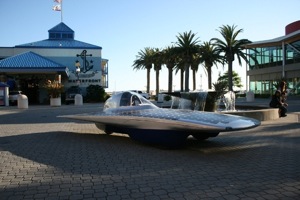 Competition is hot for this fall’s World Solar Challenge auto race in Australia and Solar Decathlon house buildathon in Washington, DC. Teams of university students across the U.S. and the world are sweating over final engineering details as they vie to create 2011’s fastest solar car or top solar house.
Competition is hot for this fall’s World Solar Challenge auto race in Australia and Solar Decathlon house buildathon in Washington, DC. Teams of university students across the U.S. and the world are sweating over final engineering details as they vie to create 2011’s fastest solar car or top solar house.
Hotrods
Helping create a state-of-the-art car that runs on solar power is “the coolest thing I can imagine doing as an undergraduate,” says Chris Cartland, leader of the 73-member CalSol crew from UC Berkeley. Each World Solar Challenge team must design, build, and drive a "rayce" car, powered only by solar energy, from Australia’s northern to southern coast across the Outback. Get online updates from the race, and try building your own sustainable-energy-powered model cars with howtosmile.org activities like Sail Car Design or Blow It Away.
Hothouses
For the Solar Decathlon, each competing team must design and construct an affordable, attractive house, run only on solar power, that generates “optimal energy production with maximum efficiency.” If Washington, DC is too far for a field trip, you might be able to tour a house from a past decathlon near you. Online, check out COSI’s solar podhouse (a past decathlon prototype), or go "off-grid" at howtosmile.org with activities like Zero Energy Housing and Make a Sun Clock.
Hot trees
Not even a college student yet, 13-year-old Aidan Dwyer has invented a new kind of solar panel, inspired by patterns of branches and leaves he saw on real trees. "Shade and bad weather like snow don’t hurt it because the panels are not flat," Dwyer says. "A design like this may work better in urban areas where space and direct sunlight can be hard to find.” Dwyer's invention could literally change the landscape of solar engineering, and the American Museum of Natural History (AMNH) has named him a winner of a 2011 Young Naturalist Award. Read more about the science and math (particularly the Fibonacci sequence) behind Dwyer's idea, and try the AMNH Using Solar Energy activity where learners can even design their own alternative energy invention.
